Megi and I were to meet in the morning at the market, where vehicles
to Murghab leave. I arrived and wasn't able to find her, and after
waiting around and periodically wandering down the main road to other
places she might be waiting (we agreed to meet where vehicles leave, but
it isn't always clear exactly where that is), I began to fear that she
might have left before me for some reason. It turned out that she and
the family she had been staying with had spent the night at a different
house, and they had only returned relatively late in the morning. So it
was pretty late by the time we were prepared to leave, and most of the
vehicles had already left, but we found a Chinese-made minivan without
too much difficulty, and were on our way before too much time had
passed. We were stuck in the back seat with some cargo, and it was
actually fairly comfortable because you don't have to worry about
elbowing the cargo or slinging your legs over them.
Chinese
minivans are popular on this route, as the road is decent enough for
them not to be shaken apart, they hold a fair number of people, and
they're dirt cheap: I think they cost something like $6,000. One of the
other passengers in our van was a bright young girl of maybe 12 or so
who was returning to her family in Murghab, and it was really charming
to watch her talk with Megi and the other passengers, as she was
absolutely nothing like the timid, downtrodden girls you see in the Fann
mountains. She was bright and outgoing, and had no fear of challenging
and disagreeing with the adult men in the van, let alone simply talking
with them.She wasn't that happy to be returning to Murghab, however, as
there simply wasn't enough there to be appealing to her
Megi
had earlier told me about her taxi ride from Dushanbe to Khorog, where
she had been similarly surprised at just how different Pamiri women were
from the lowland Tajik women she was used to in Kulob. The women in her
car showed no fear or hesitation to dominate and chide the men, telling
her that in Pamiri families it is women who wear the pants in the
family. This is so different than most of Central Asia, and Tajikistan
in particular, but hugely refreshing, and a large part of the reason why
Pamiris are my favourite people of Central Asia.
On the road to Murghab
For the first hour or so the M41 east of
Khorog has scenery similar to the road between Khorog and Ishkashim,
which is to say that it's relatively verdant with lots of trees and
small villages. After a while, however, the valley rises and widens into
a more desolate and rocky environment of the type we might expect to
see in high-altitude mountain plains, rising to the deceptively high
Koi-Tezek pass (4,272 meters high, even though the pass is not between
close mountain but simply the crest of a long hill in the middle of a
wide valley).
 |
| Entering the high plains. |
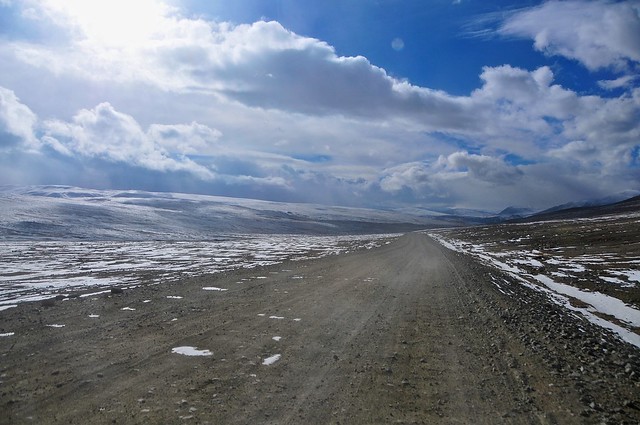 |
| Near the
Koi-Tezek pass. Despite the snow, it feels like a desert and it's
difficult to imagine that much vegetation grows in this stony valley,
even in the summer. |
 |
| Mountains to the south. |
 |
| We came across
a car stopped at the side of the road, and got out to stretch our legs
while the drivers talked. It turns out the other car had run out of
gas, so we gave him a ride to fetch some. |
 |
| The road is often washboard and bumpy, but isn't overly rocky. |
 |
| Chinese minivan in need of gas. Not the best place to get stranded. |
 |
| We dropped the
driver here to get gas; I hope he found some. When I see a building
with a gabled roof line, I imagine that it's a Soviet-era building
constructed by the government. This may explain why it's abandoned. |
After Koi-Tezek the road descends
gradually, until you come across a bend in the road near the turnoffs
for Bulunkul (to the north) and Langar (to the south) where the road
follows a ridge above Sassyk-kul and other lakes on the plain below. As
this is a much-praised view, both Megi and I wanted to get a picture.
Megi said she would pretend she had to go to the bathroom, but in the
end she simply asked if they would stop for a photograph, a request the
driver happily obliged.
 |
| Sassyk-kul from the vantage point of the M41. |
 |
| Panorma of the valley and the M41. |
 |
| As the lakes have no outlet, they are naturally saline. |
 |
| The M41 stretches into the distance. This stretch is more or less paved. |
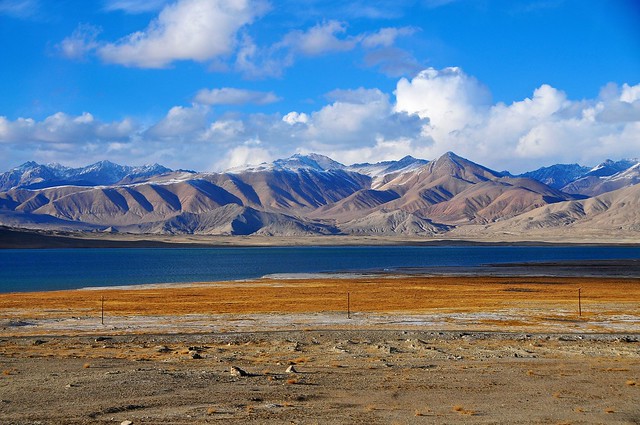 |
| The lakes from down in the valley, shortly before Alichur. |
 |
| A river near Alichur, fringed with ice from the overnight frosts. |
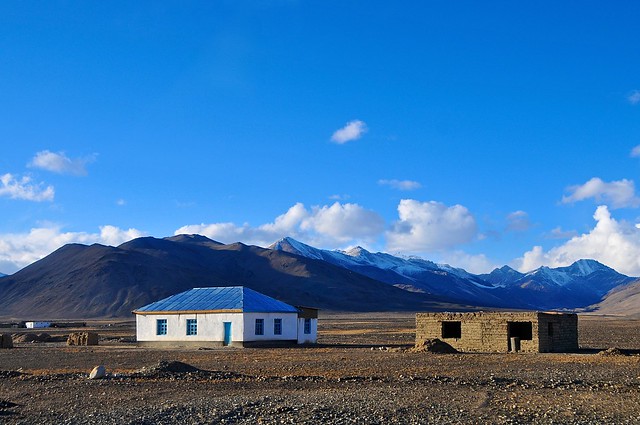 |
| Buildings just
east of Alichur. It's near here that our van was chased down and pulled
over by a Pajero full of burly young men in shearling bomber jackets.
The driver talked with them outside, and I wondered what the hell was
going on, but they let us continue. |
 |
| Looking north. |
Because just about every car ride needs to stop for a meal break, we
stopped in Alichur and pulled up to one of the non-descript boxes of a
building, which we discovered to be a restaurant when we went inside. I
decided to walk around the village instead of eating whatever they
happened to be serving (fish is the specialty in Alichur, and I don't
eat fish).
 |
| Yaks graze near Alichur. |
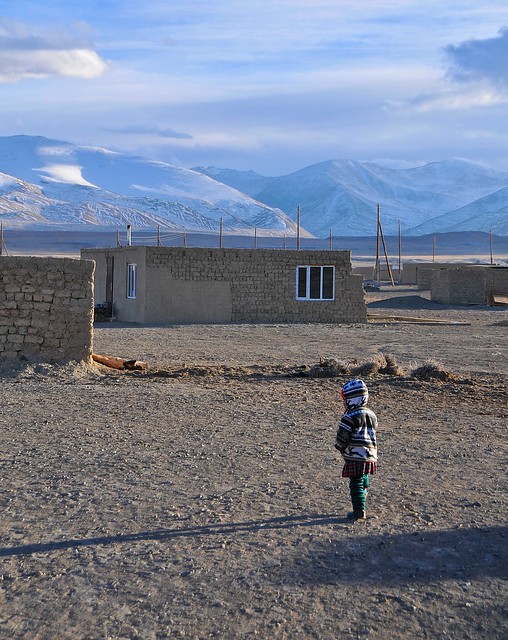 |
| Youngster out and about in the harsh town. |
While walking around Alichur I was
approached by one of the buys from the SUV who had stopped us earlier.
It turned out that they weren't police or security guards (or worse),
but a health-services crew from the Aga Khan Development Network who
were traveling to rural communities in the Pamir to deliver medical
equipment. And the reason they pulled us over earlier was because the
guy I was talking to needed to go the Murghab, while the rest of his
crew were heading to more rural communities, so he wanted to see if he
could hitch a ride with us... and since we were dropping someone off in
Alichur, he was joining us there. Anyway, he had come to talk to me to
invite me to stay with him, saying that I could stay for free with him
at the hospital, while he would be able to practice his English (which
was pretty good). I said that that sounded good so long as the ofer
extended to Megi, and he said that would be fine. And so we picked up a
passenger to Murghab, and Megi and I saved some money.
 |
| At the turnoff to our truck-stop restaurant. |
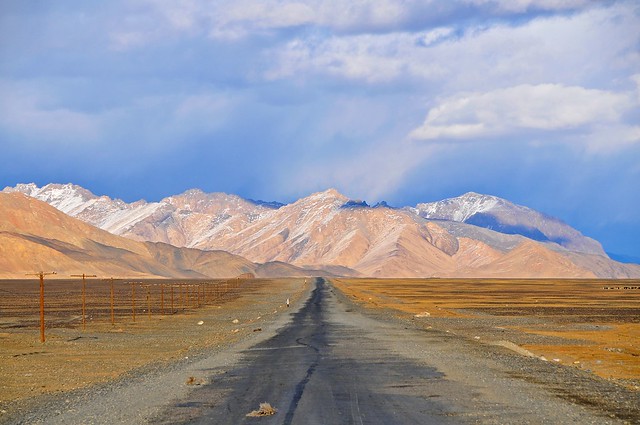 |
| The road out of Alichur, towards Murghab.. |
 |
| The red lines
striking through the town name let you know you're leaving the village.
You know, just in case there was any confusion about that. |
 |
| I wonder what this looks like in summer. |
 |
| Stark shadows. |
 |
| I'm guessing this tiny little shack is an outhouse. |
 |
| There are no real streets to speak of in Alichur. |
 |
| Long shadows as the sun sets. It was only 4:35, and still almost two months before the winter solstice. |
 |
| The
whitewashed and mudbrick walls of these flat-topped houses are more what
I imagined houses in Bolivia or Peru might look like. |
 |
| About midway between Alichur and Murghab. |
It was dark by the time we pulled into
Murghab, just before entering which we ran into only the second
checkpoint station I encountered in Tajikistan: this and the security
inspection outside Ishkashim were the only places where I had my
passport and GBAO permit checked.
Budget
October 28, from Khorog to Murghab: 131 somoni
- Taxi to Murghab: 120 somoni
- Breakfast in Khorog: 8 somoni
- Bread in Khorog: 3 somoni



























Wonderful photographs....
ReplyDelete